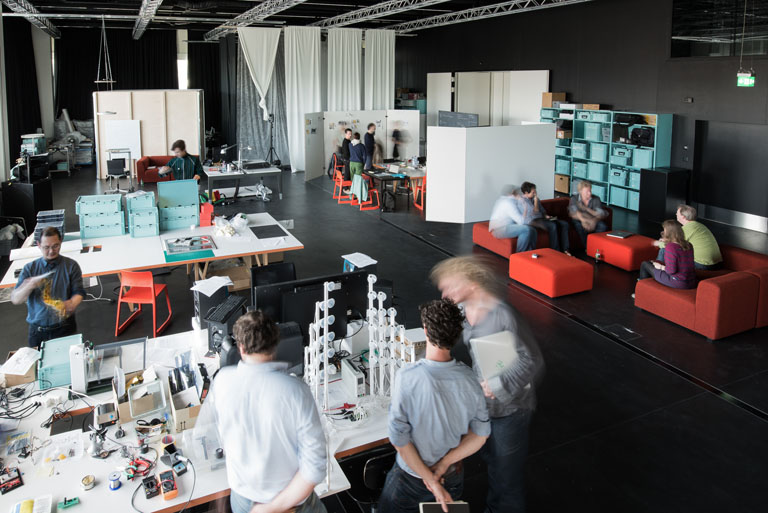Critical media lab basel
Issue: XXVI.1 January - February 2019Page: 16
Digital Citation
Authors:
Shintaro Miyazaki, Claudia Mareis
How do you describe your lab to visitors? The Critical Media Lab Basel is an integral part of the Institute of Experimental Design and Media Cultures (IXDM) at the Academy of Art and Design FHNW in Switzerland. We develop new paths of critical thinking for design, media practices, and their cultures, and also aim for a playful and experimental closeness of practice and theory. We have realized that so far new media have not lived up to their promising radical power. Therefore, our lab is a place where the potentials and limitations of old and new media—including their designs—are used for critical questioning, experimental thinking, and practice-based explorations.
On average, about four to six research projects (funded by the Swiss National Science Foundation) share a black-painted area of 400 square meters with a 4–5 meter headspace, including some space for equipment storage and a large meeting/teaching section. We are surrounded by huge windows on three sides. A grand hoist (depth 4.5m, width 2.6m, height 4m) allows us to design and build installations with large parts. The lab is inhabited by a mixture of research projects. On average, teams of two to three researchers do projects that involve experimental installations in the lab; others conduct fieldwork, interventions, or participatory work outside the lab. Some projects focus more on content, using conventional audiovisual media or even publishing books.
How many people are in the lab, and what is the mix of backgrounds and roles? We have a large, highly mixed team with backgrounds as diverse as sociology, chemical engineering, interior design, anthropology, history of science, creative coding, media studies, visual communication, art history, experimental design, artistic research, architecture, philosophy, and service design. Our director is Claudia Mareis. We have about five long-term senior researchers taking the role of principal investigators with their own research projects. Additionally, there are eight to 10 project-based postdoctoral or senior researchers, half a dozen Ph.D. students, and a handful of junior researchers who are coding or designing specific commissions. We also have a broad range of external collaborators—artists, filmmakers, and product designers for specific productions.
 |
Test environment, Designed Immediacy (2015–2017, SNSF-Project No. 156977). |
What is a unique feature of your lab? We have no unique technical features besides the generous lab space, but we do have unique approaches such as our method mix, which combines humanities-driven approaches with practice-based ones. We are working within a design and art university, which is quite unusual, since media labs are usually located within engineering departments. This implies that we value historical, societal, and political inquiries. The conceptual undoing of white-male-dominated biases incorporated into information technology (also known as decolonization), for example, is equally important, as are experimental design methods such as prototyping, design fiction, experimental fieldwork, participatory design, and creative coding. With Thinking Toys for Commoning, for example, we co-design with urban housing cooperatives a set of games and digital toys, which are informed by computational simulations of social dynamics, utopian visions, and histories of anarchist squatting. These thinking toys—as we like to call them—will allow us and the cooperatives to playfully self-reflect the way we want to live together in the near future.
 |
Conference event in the lab. |
How do people interact in your lab? We have biweekly team meetings and colloquia where we engage more with some of the research topics of our colleagues, exchange insights, or have invited guests. Every six months, we organize an intensive gathering for three to four days where we exchange insights and feedback from our projects and also try to transform our strategies and design new research topics or directions for the future. We organize conferences with our peer-research communities and also try to link to our region by organizing workshops, events, or exhibitions. Right now, we are designing a small showcase platform in the middle of the lab. It is a place where visitors can get an overview of our projects; it's also another source of inspiration for our colleagues.
 |
Theater-performance event Syntegrity in collaboration with the municipal theater of the city of Basel. |
What is one feature of your lab you want and do not have? Because we work in a shared space, we definitely need more flexibility with soundproof pods and booths so that we can use noisy tools, build things, write, teach, program, meet, and have informal conversations all at the same time.
 |
Audio walk, Times of Waste (2015–2018, SNSF-Project No. 156185). |
We challenge conventional understandings and roles of design and science.
What is the one thing you see as most important about the work you do there? We challenge conventional understandings and roles of design and science. We try to open up fresh interdisciplinary spaces for critical thinking and design. Problem solving is generally not our main aim—sometimes it is, but we would rather address problems and create moments of criticality, which generate a diversity of solutions. Sometimes these insights and designs are even more troubling and confusing but in a meaningful, helpful, and inclusive way.
 |
A Ph.D. student tinkering with electronics. |
©2019 ACM 1072-5520/19/01 $15.00
Permission to make digital or hard copies of all or part of this work for personal or classroom use is granted without fee provided that copies are not made or distributed for profit or commercial advantage and that copies bear this notice and the full citation on the first page. To copy otherwise, to republish, to post on servers or to redistribute to lists, requires prior specific permission and/or a fee.
The Digital Library is published by the Association for Computing Machinery. Copyright © 2019 ACM, Inc.



